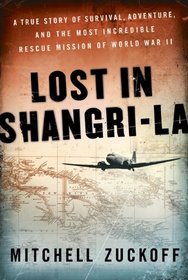This was a very interesting account of an incident that occurred during the waning days of WWII on the island of New Guinea. In May 1945, a group of over twenty service men and women stationed at Hollandia, New Guinea, went on a sightseeing trip aboard a C-47 plane to see a lost valley over 100 miles south dubbed as "Shangri-La" after it was discovered by one of the base's pilots. The valley contained native villages which could be seen from the air along with the natives themselves who appeared to be very tall and could also be headhunters or cannibals. And then disaster struct; the plane crashed into a mountainside killing everyone on board except for three survivors. The survivors were a WAC named Margaret Hastings who was badly burned by the crash and was developing gangrene in her legs; John McCollom a lieutenant who lost his identical twin brother in the crash; and Kenneth Decker who was also severely burned and had an open head wound. The group was able to leave the crash site and hike to a clearing where they were sighted by a search plane. But how could they be rescued?
A group of men parachuted in to provide medical services and establish a base to work on extracting the injured. The medics and most of the men who came in were Filipino paratroopers. The medics were able to treat the wounds but then the group had to hike to the main valley for rescue. Along the way and at the valley they were surrounded by the natives who turned out to be mostly friendly and provided needed assistance. But rescue was still being debated by the army. They couldn't fly in a helicopter because of the altitude; planes could not land there; an overland hike was prohibitive because of the terrain and the possibility of hostile natives or Japanese soldiers in the area. Eventually they came up with a plan to use gliders to get the group out of the valley. This was a very fantastic rescue which could have been written as adventure fiction.
Today this event is pretty much forgotten but at the time it was front-page news along with the rest of the events of WWII. A former movie personality actually parachuted into the camp and filmed a lot of what happened before and during the rescue. Some of his footage is available on Youtube and called "Rescue from Shangri-La."
I really enjoyed this very compelling read. Zuckoff really did his research including talking with some of the people involved. He went to New Guinea and was able to track down some of the natives who were present at the time when they were children. He provided a lot of insights into the native people including their customs, warlike tendencies, and dress (or lack thereof). A very good overall recommendation for this one.
A group of men parachuted in to provide medical services and establish a base to work on extracting the injured. The medics and most of the men who came in were Filipino paratroopers. The medics were able to treat the wounds but then the group had to hike to the main valley for rescue. Along the way and at the valley they were surrounded by the natives who turned out to be mostly friendly and provided needed assistance. But rescue was still being debated by the army. They couldn't fly in a helicopter because of the altitude; planes could not land there; an overland hike was prohibitive because of the terrain and the possibility of hostile natives or Japanese soldiers in the area. Eventually they came up with a plan to use gliders to get the group out of the valley. This was a very fantastic rescue which could have been written as adventure fiction.
Today this event is pretty much forgotten but at the time it was front-page news along with the rest of the events of WWII. A former movie personality actually parachuted into the camp and filmed a lot of what happened before and during the rescue. Some of his footage is available on Youtube and called "Rescue from Shangri-La."
I really enjoyed this very compelling read. Zuckoff really did his research including talking with some of the people involved. He went to New Guinea and was able to track down some of the natives who were present at the time when they were children. He provided a lot of insights into the native people including their customs, warlike tendencies, and dress (or lack thereof). A very good overall recommendation for this one.





